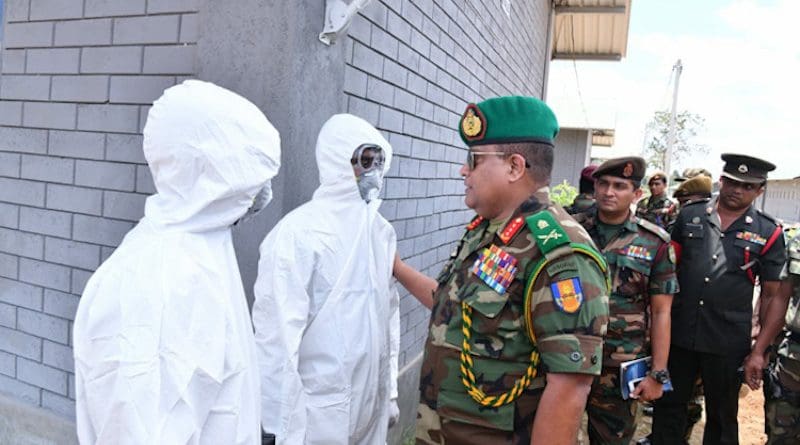From Battlefield To Fighting COVID: Sri Lankan Armed Forces Fight Invincible Terrorism – OpEd
By IDN
By Sugeeswara Senadhira
Today marks an important landmark in Sri Lankan history. Twelve years ago, when the three-decade-old conflict with the Liberation Tigers of Tamil Eelam (LTTE) was brought to an end, the members of the Armed Forces were widely respected and honoured for the valiant role they played in defeating one of the most ruthless terrorist outfits in the world.
While that exalted position did not diminish over the years, today the armed forces have transformed into an efficient humanitarian relief delivery outfit. When Sri Lanka was hit by the first COVID-19 wave, President Gotabaya Rajapaksa who was the Defence Secretary when the army defeated the LTTE in 2009, deployed the army and the intelligence services in contact tracing, monitoring lockdowns and other humanitarian roles, assisting the medical sector.
Thus, there was a sudden upswing in the illustrious position of the Armed Forces in the public eye due to the courageous role they are playing in the national campaign to curb the COVID-19 pandemic. Though there are some, especially in the opposition camp, that have expressed misgivings about the army taking on so-called “civilian” roles, yet a majority of the populations have no qualms about it.
The invaluable contribution by the Armed Forces at this time of a health crisis clearly proved that there is no clear distinction between the important role of the forces during peace and war.
Infections did not hinder
The relentless campaign by the health authorities, ably supported by the Armed Forces, did not diminish even after it was found out last year that hundreds of sailors and officers of the Sri Lanka Navy had tested positive for COVID-19. The spread in COVID-19 cases at the Welisara Navy Camp exemplified the seriousness of the threat of the pandemic faced by the health workers and Armed Forces. In April 2020, while assisting health authorities in community work to control the spread of COVID-19, 906 Sri Lankan Navy officers were infected. Luckily, this was an isolated case and all of them recovered later.
Almost all other branches of Security Forces (and police) who were at the forefront of the fight against the dreaded pandemic are largely free from infection. As the Army Commander General Shavendra Silva said the Army and other forces stepped up their efforts in the campaign against the pandemic with added resolution after this episode.
Tackle virus spread
For the Security Forces, being instruments of last resort for national security, disease prevention for force preservation and effectiveness is extremely important. Armed Forces maintain very high standards of hygiene and sanitation and are supported by an excellent Medicare infrastructure and personnel. That is the very reason why the Security Forces were deployed to tackle the spread of the virus.
However, the nature of military organisations, their habitat, training and modus operandi, both during peace and war makes them extremely vulnerable to contagious infections. Despite the odds, the military has to persevere in order to pursue its assigned mission of combatting internal and external threats. In addition, the military has to assist the civil authorities in fighting the disease.
Military forces across Europe have scaled back operations and imposed stricter rules on personnel to try to stem the spread of the coronavirus among staff who often live and work in close quarters, making them more vulnerable to infection. Preventing the virus’ proliferation among the military is important both for national security and because specialist Army, Navy and Air Force units are being drafted in to help Governments tackle the virus in many countries.
Epidemics and natural disasters
Conflict hardly ever pauses due to epidemics and natural disasters. In December 2004, the tsunami caused severe damage in many coastal areas of Sri Lanka and the Army was rushed for immediate rescue missions. Their first task was not to provide relief to the beleaguered population but to rescue as many as possible from imminent death. The role played by the military was hailed by the people, including the Tamil and Muslim masses then living in LTTE-controlled areas in the North and the East.
Since the time when the Presidential Task Force appointed by President Rajapaksa decided to deploy Security Forces in the campaign to curb the COVID-19 pandemic, Sri Lankan Armed Forces have done exceptionally well in ensuring force preservation without impinging on the ongoing operational missions and tasks in aid of civil authorities to fight COVID-19.
However, it is a long haul, and the real challenges lie ahead. Although Sri Lanka could be happy about its successes in combating the pandemic so far, the country cannot afford to let its guard down. As health authorities stressed, the efforts of the health sector and the Armed Forces must be backed by more aggressive testing to detect the virus affected.
The military will have to continue its role especially because of the medical experts’ view that it is likely that the Armed Forces as a whole, will develop herd immunity much earlier than national herd immunity which comes after 50-60 % of the population gets infected. Most of the armed forces personnel have already been vaccinated.
Hence, the members of the Armed Forces will have an important battle ahead at this 12th anniversary of the victory against the ruthless terrorists. The 2009 battle was against a visible terrorist group and today’s fight is against an unseen but deadly pathogen. In this battle, the role assigned to the Armed Forces is equally critical for the nation and its people.

